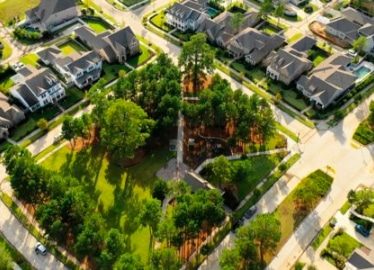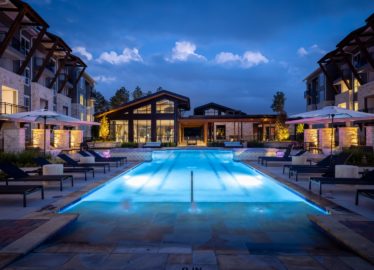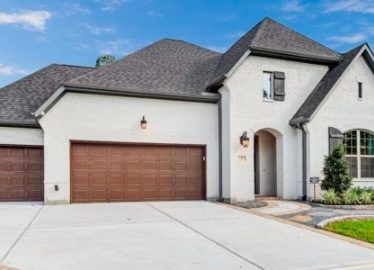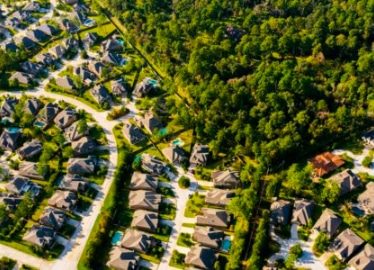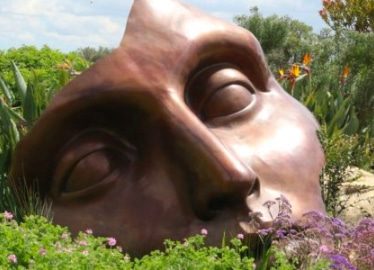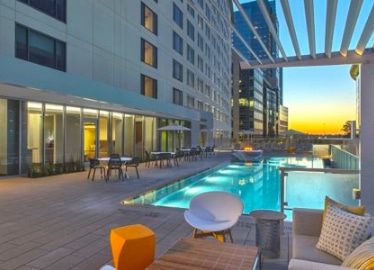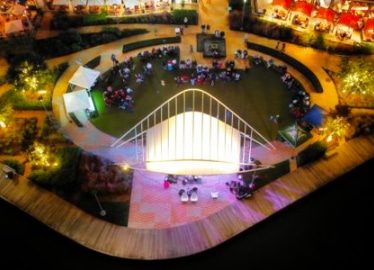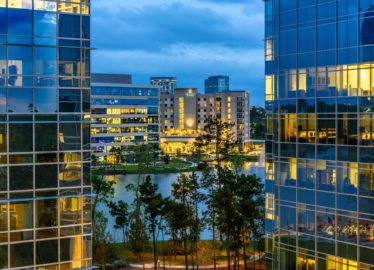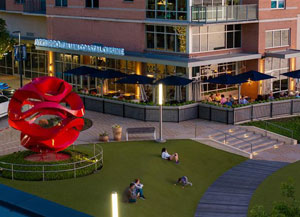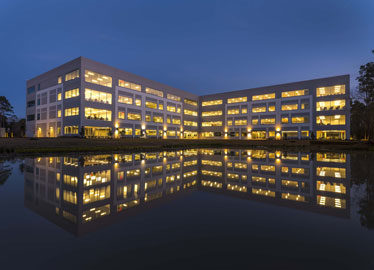By Laura Landsbaum
The Woodlands has come a long way in its 50 years (the big anniversary is officially next year), and it all started with George Mitchell. Even after all these decades, The Woodlands is still centered around Mitchell’s vision.
Growing up in Galveston, George Mitchell enjoyed the community feel of the corner store and getting to know his neighbors, according to his son Scott Mitchell. As an adult living in Houston, George Mitchell’s experience was very different. Something much more isolating.
“Dad had the exact opposite of that,” Scott Mitchell says. “And he wanted to create something else. He thought about the neighborhood village idea where you could live and work and would create a sense of community.”
An avid outdoorsman, George Mitchell loved to fish, hunt and play tennis. “He fell in love with the forests of the Piney Woods,” his son says.
George Mitchell wanted his own woodlands. A place where a natural forested environment would be immersed in the very first live, work, play, pray and learn master planned communities in the country. In fact, when The Woodlands began the now ubiquitous Live, Work and Play mantra that many use, a marketing slogan wasn’t even close to being part of the lexicon. Instead, Mitchell fixated on building something authentic and community centered.
So how do you build The Woodlands from scratch? George Mitchell had an approach to planning that carried through his oil company and his real estate, Robert Heineman notes. Heineman, who became the vice president of planning for Howard Hughes, working almost 50 years for the company, would know. He had a front row view of The Woodlands’ early days.
“He kind of thought ‘If I solve the problems of the future, the present will take care of itself’,” Heineman says.
George Mitchell’s vision was designed to last.
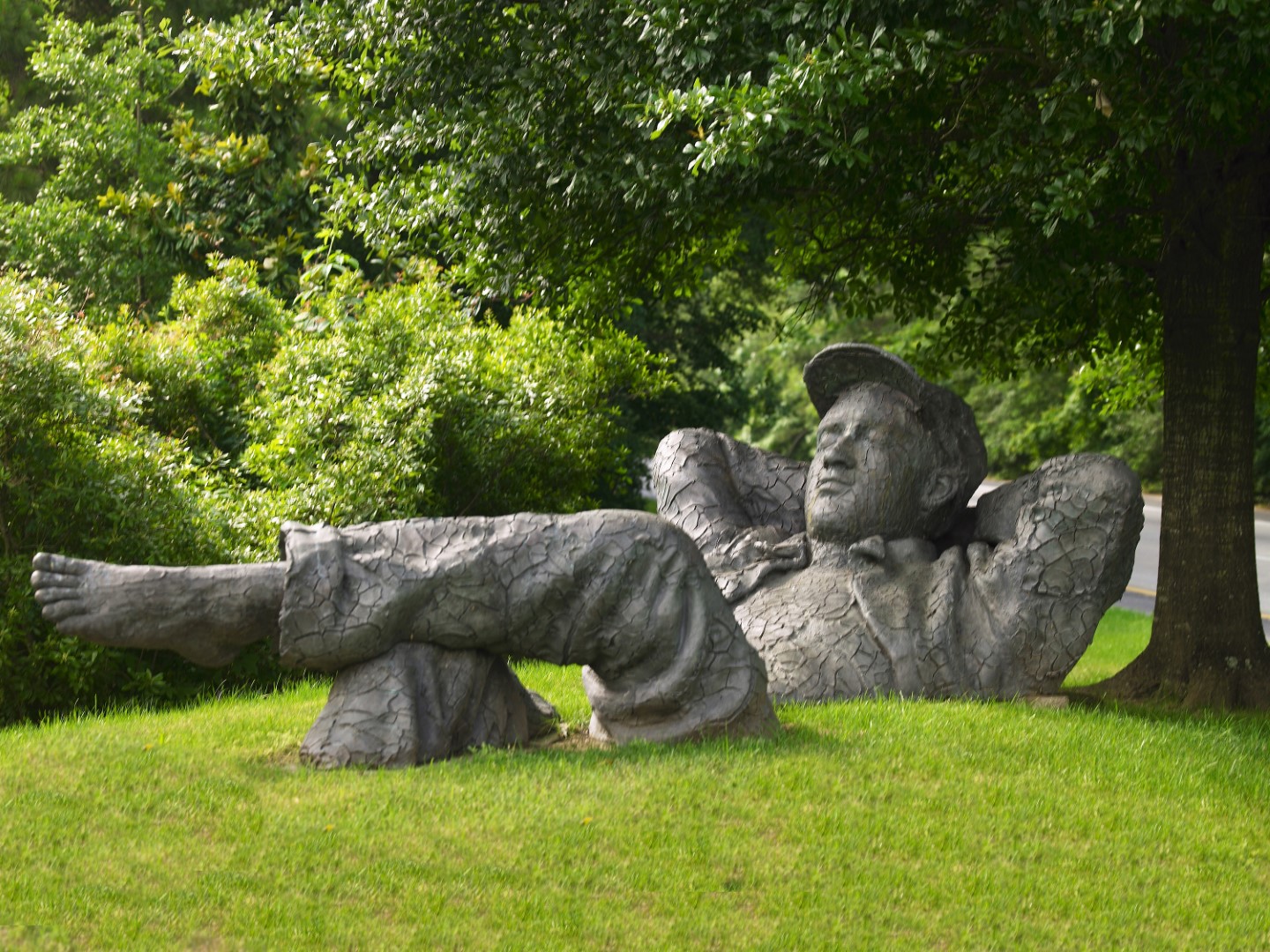
The Woodlands was always meant to be a place that encouraged dreaming.
When The Woodlands opened in October of 1974, it was about 17,000 acres. Subsequent purchases of adjacent land have brought that total up to over 28,000 acres today. The Woodlands was built following the idea of — and improving on — the examples of two cities, according to Heineman — Columbia, Maryland and Reston, Virginia. Heineman, who began working to help develop The Woodlands as a wide-eyed summer intern in 1971, stayed on until his retirement with Howard Hughes in 2021. George Mitchell, Heineman and the entire development company worked with famed landscape architect Ian McHarg to help lay out what grew to be The Woodlands.
Preserving the Environment
The Woodlands would dedicate an unprecedented amount of land for permanent preservation, and it’s a defining feature of one of the most unique communities in the United States.
“On the first commercial buildings built in The Woodlands over on Timberloch Place, which had reflective glass — during certain times of the day, you couldn’t see the buildings because they were reflecting nature and the trees,” Heineman says. “And the commercial sales team didn’t know how they could lease a building that couldn’t be seen on the street.”
That first office building completely leased. Now the office leasing rate in The Woodlands is approaching 90%, far above the 75% in Houston for Class A office.
One of the keys in the growth of The Woodlands is that George Mitchell and his team refused to put that growth ahead of the community’s underlying principles. No matter how big the requesting company might be.
McDonald’s was the first fast food restaurant in The Woodlands, but the community’s strict guidelines on signage and business placement made that a tough initial sell as the fast-food goliath initially balked at this then new community’s restrictions, which required that McDonald’s blend into the trees — and not having blaring signs — just like every other business.
“(McDonald’s) had a fear that they’d be invisible,” Heineman says.
The Panther Creek McDonald’s went on to be one of the highest volume McDonald’s in all of Texas, even without soaring golden arches over the tree canopy. And with that success, “getting other retail into the centers was much easier,” Heineman notes.
First, George Mitchell stood his ground.
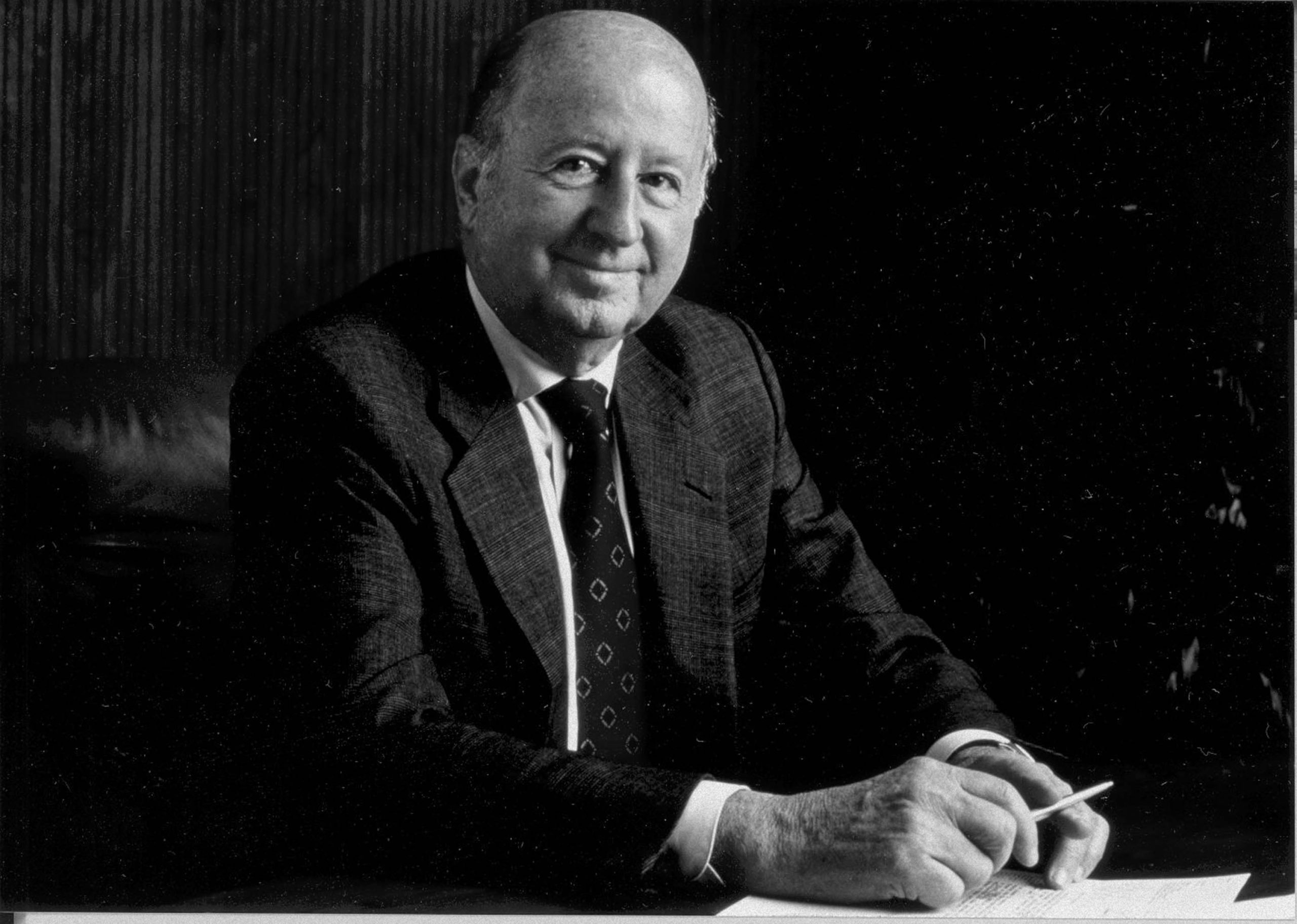
George Mitchell always had a firm future-looking vision of what The Woodlands could and should be. (photo courtesy of The Cynthia and George Mitchell Foundation)
According to Tim Welbes, Former and Retired Co-President of the Houston Region, Howard Hughes, the vision for The Woodlands always included having affordable apartments, entry-level homes and move-up housing in order to have a mix of choices.
“The national builders have the ability to bring in the most affordable house,” Welbes says. “The national builders told our planners what had worked in other parts of the country. But we wanted something different. We wanted bigger windows to bring the outdoors in and the builders countered that they were nationally accepted designs.”
The Woodlands’ visionary team won that fight too.
And just how future looking was that vision of Mitchell’s? Heineman sketched out The Woodlands Waterway on the back of a napkin in 1972. It all began as imagining what began as a drainage ditch to be so much more, picturing it as a potential future hub of the community instead. Construction on The Waterway did not actually begin until 1989, 17 years after that napkin sketch. Yes, this has always been a long-term kind of place.
“That is a shining example of a commitment to a long-range vision,” Heineman says.
That vision has come to life — and then some.
George Mitchell and his wife, Cynthia Woods Mitchell, were also committed to the arts and philanthropy. The Mitchells were responsible for creating The Cynthia Woods Mitchell Pavilion in 1990, now the #1 outdoor amphitheater in the world, as well as introducing Interfaith of The Woodlands in 1973.
“Howard Hughes has stayed true to the vision of George Mitchell, helping ensure The Woodlands is a self-sustained master planned community, a natural refuge that nurtures the best in family, quality of life and career opportunities,” says Jim Carman, president — Houston Region for Howard Hughes. “We are honored that The Woodlands is one of the most acclaimed master planned communities in the nation and continues to be a global blueprint for environmentally responsible development.”
The Woodlands of Today and Tomorrow
Charles Blain, the president of the Urban Reform Institute, tabbed The Woodlands as one of The Next Great American Cities, even though it’s not technically a city and is on the cusp of being 50 years old.
Driving through The Woodlands today, you can see that original vision still going strong with nature still a dominant feature, and with commercial signs restricted from the blaring lighting you’ll find in so many other areas. These days, more than 120,000 people and over 2,400 businesses — from Fortune 500 companies to mom-and-pop shops — call The Woodlands home.
But driving the main thoroughfares, you’d still largely never know that. You’re still engulfed in nature and trees. It feels like you’re several steps removed from the hustle and bustle of life, even though almost all the perks of a thriving urban hub can be found in The Woodlands Town Center. Of course, the 151 neighborhood parks, with every home in the township a quarter of a mile away from one at most, and the 220 miles of connected hike and bike trails, provide a natural retreat.
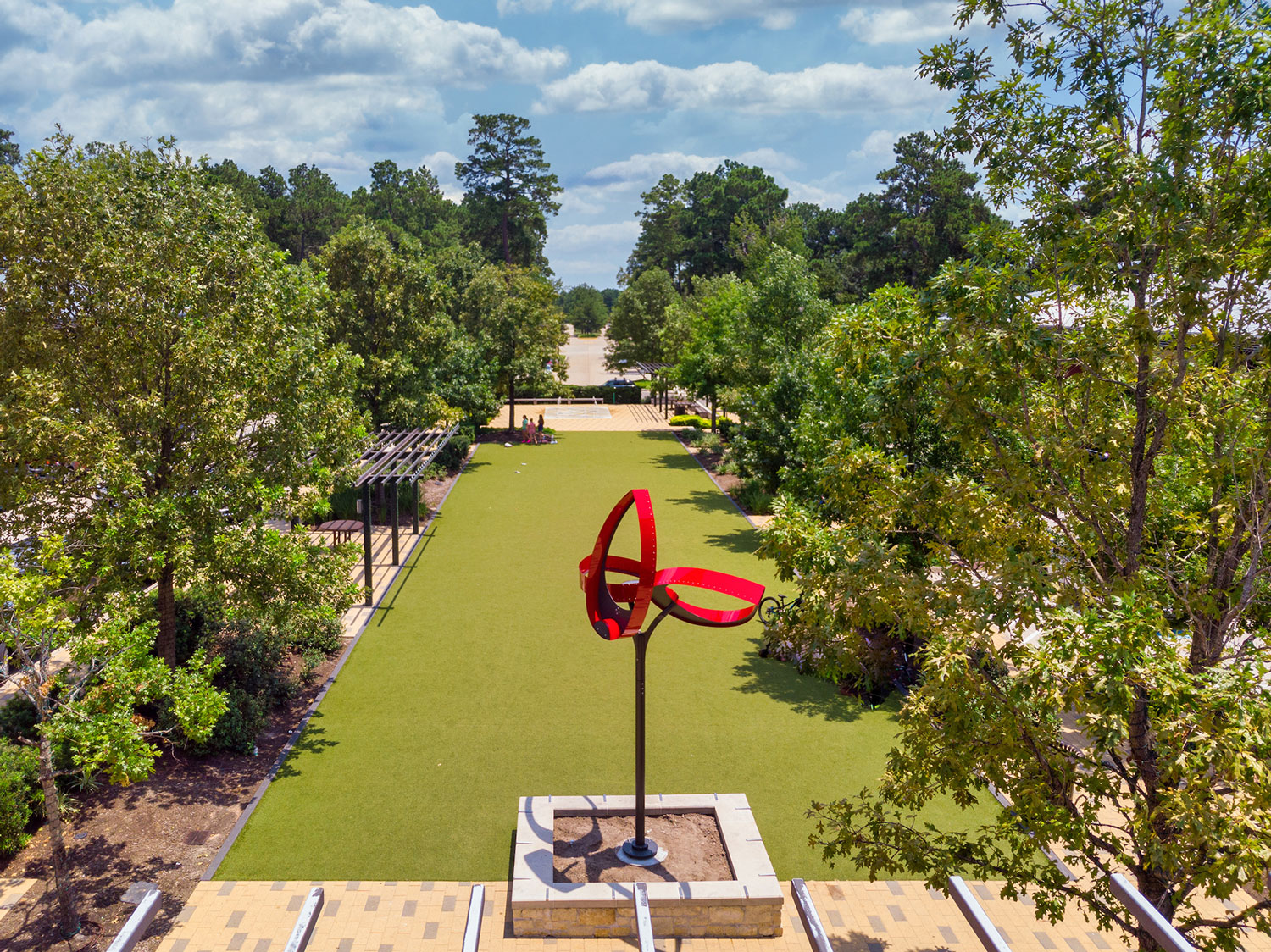
Creekside Park Village Green is just one of 151 parks in The Woodlands.
Still, The Woodlands wouldn’t be the place it is today — the community that George Mitchell imagined — without its most important asset of all. The people who live there.
The residents created a runaway success by engaging with their community. Just like George Mitchell envisioned it five decades ago. The founder surely would be proud of what The Woodlands is growing up into, nearly 50 years in.
Many thanks to The Woodlands 50th Anniversary Partners:
FOUNDING – Howard Hughes
LEGACY – Woodforest National Bank
HERITAGE – Waste Connections Inc.
GOLD – Entergy Texas, Houston Methodist The Woodlands Hospital
SILVER – SVN|JBeard Real Estate, The John Cooper School
PRODUCER – The Woodlands Township

